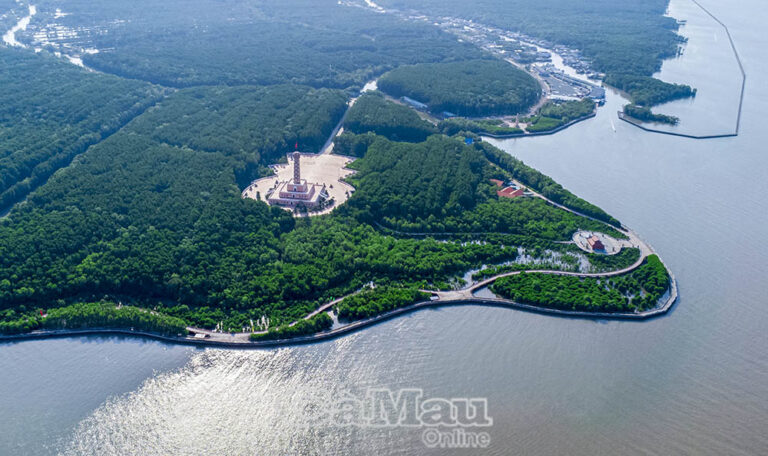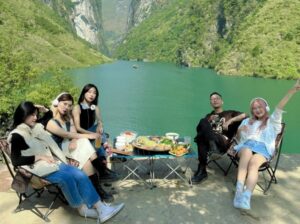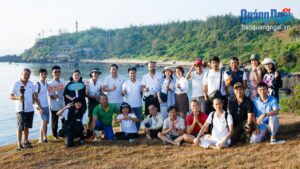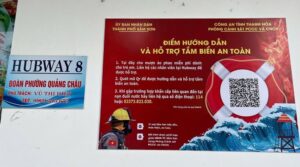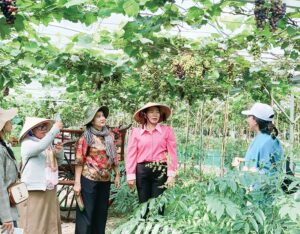The Bo Ban Communal House is located in Bo Ban 2 Village, Hoa Phong Commune, Hoa Vang District, Da Nang. Tourists departing from the city center will simply travel on the former National Highway 14B until to see the Tuy Loan traditional market, then turn left and continue to run a distance of around 1km along a canalside road to reach the communal house.
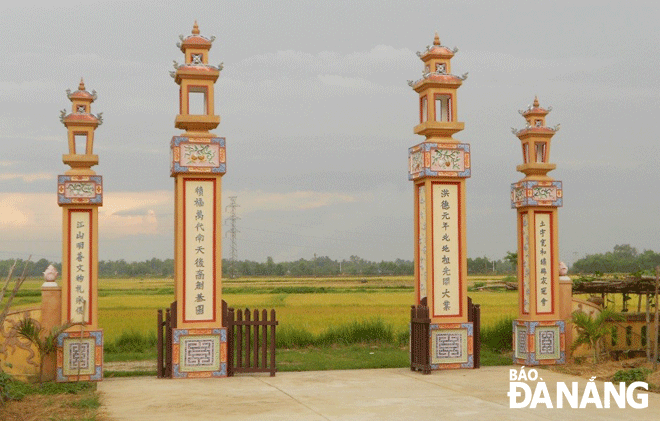
The newly-built entry point to The Bo Ban Communal House. Photo: G.H
According to documents provided by the Hoa Vang District Authority, the Bo Ban Village was founded in the late 15th century (about 1476), by the ancestors of the Tran, Ho, Truong, and Nguyen clans from Thanh Hoa and Nghe An provinces. They moved to the South to reclaim land and settle down their own business in this village. They were followed by Tan, Dinh, Nguyen, Pham and other clans during the reign of King Le Hien Tong (1740-1786). The material and spiritual life of the villagers has been improved gradually during the process of the construction and development of the village. Therefore, villagers needed a place to host annual festivals and worship the village’s founders . As a result, they joined together to build the Bo Ban Communal House.
The communal house was built on the Tam Vi Temple Mound to the east of the village in 1800, and it was mainly made of mud and bamboo with thatch roof. In 1852 under the reign of King Tu Duc, elderly villagers and dignitaries of the village decided to move the communal house to larger location due to the increasing population of the village. The communal house was then moved to a cool terrain which boasted unique geological shape. A high temple was behind the communal house while there was the Tam Vi Temple to the right, the Oi mound to the left, and a vast field to the front. Besides, the communal house was close to the Cam Toai Village and the Yen River. The communal house was re-built with the contribution of money and efforts of the entire villagers, so it was quite beautiful with unique architecture while it brought with it cultural identity and traditional art of Viet Nam.
On March 25, 1906, the communal house underwent its first restoration but its architecture remained unchanged. On May 12, 1990, the communal house underwent further restoration due to its damages caused by the storm No. 2 on April 19, 1989.
Accordingly, the communal house was re-constructed with two tiled roofs while bamboo pillars were replaced with wooden ones of jackfruit and pine wood. However, carving design of the communal house was left unchanged with animal carvings featuring dragons, unicorns, turtles and phoenixes in ancient times while a pair of bats was added to carvings. In 2007, the Bo Ban Communal House underwent a large- scale restoration with funding from the state budget. In 2011, the construction of external works was undertaken, including fencing, entrance gate, and garden, in order to make the communal house even more spacious.
The Bo Ban Communal House was recognized as a national-level relic site by the Ministry of Culture and Information in accordance with the Decision No. 01 dated January 4, 1999. The Bo Ban Communal House boasts great historical and cultural values as it was built in the 19th century with ancient architecture and sophisticated carvings by artisans from Kim Bong Village located in Hoi An, Quang Nam. Carving patterns on the trusses, and pillars include the dragon's head, leafy tail, and four different illustrations of trees to symbolise the four different seasons of the year: spring, summer, autumn, and winter. All carvings were made in this relic site to create harmony in its design.
Meanwhile, roof decorations feature ceramic grafting with the images of two dragons fighting over the same painting, two phoenixes fighting over the same pearl, and more, all helping the Bo Ban Communal House to be imbued with traditional art and cultural identity of Viet Nam. The Bo Ban Communal House hosts festive events where the villagers perform rituals to honour their ancestors, as well as pray for good weather and a bumper crop.
In the spring and autumn, the villagers perform rituals at the Bo Ban Communal House to pray for God's blessing. This relic site is also a place where the villagers gather to celebrate the Lunar New Year, and greet each other with New Year wishes on the first day of the Lunar New Year. Especially, the festive event held at this relic on the full moon day of the second lunar month every three years is the village’s biggest event to honour their ancestors as this event usually sees a large number of participants. In addition, the full moon day of the eighth lunar month August will witness ritual practices to pray for peace. The festive events provide the opportunity for Bo Ban villagers to honour their ancestors, preserve and promote local and national culture, hereby, encouraging them to increase solidarity to make their hometown more beautiful and prosperous.
Reporting by Gia Huy - Translating by H.L


